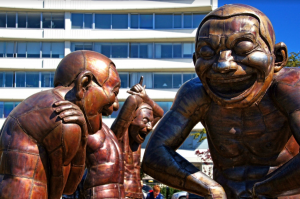by Ben McGuinness, Peak Associate
The Vancouver Biennale is a non-profit whose sometimes beautiful, sometimes absurd artworks have popped up all around Greater Vancouver since its founding in 2004. By collecting donations they are able to hire artists to create these breathtaking public art pieces. The current 2018–2020 Exhibition is its fourth thus far in a mission to turn our parks and public spaces into an Open Air Museum.
Given their conspicuously public nature, the Biennale’s works are sometimes only on display temporally — possibly adding to their poetic value. But others have stood for years as iconic testaments to Vancouver’s everyday life — oddities and all. Here are four of these iconic works that every Vancouverite should know!
A-maze-ing Laughter
Artist: Yue Minjun (China)
Where to find it: Morton Park at Davie and Denman

Tourists from around the world have taken home photos of themselves mimicking the eccentric and nearly unsettling statues of A-maze-ing Laughter. This piece from the 2009–2011 eExhibit features 14 sculptures of a squat man — a caricature of the artist himself — in silly poses with the same absurd smile on his face. Drawing from his background in Cynical Realism (a movement exploring China’s rapid urbanization and opening to the West, often with a satirical or humorous tone), Yue combines humour, realism, and repetition to engage viewers with the contradiction of loud images in a still sculpture. The inclusion of ‘maze’ in the title alludes to the perplexity of the subject’s insanely good mood, perhaps encouraging us to reflect on why his laughter is so strange to us.
The piece is well-placed at the heart of English Bay, where beachgoing families and drunken clubbers alike may stumble upon it in the mood to embrace the shameless a-maze-ing laughter of the quiet statues. We dare you to become the 15 statue for your own photo op!
Acoustic Anvil: A Small Weight to Forge the Sea
Artist: Maskull Lasserre (Canada)
Where to find it: Leg-in-Boot Square in False Creek
At first, the Acoustic Anvil could be mistaken for the type of industrial object one should find by the sea, yet on a double-take you’ll notice how its rusty utility is out-of-place in a district designed for leisurely amusement. It serves as a reminder that the history of Vancouver can sometimes be hard to see under the gloss of modern glass towers and family-friendly public spaces.
Contributing to the current 2018–2020 exhibition, artist Lasserre explains that the anvil’s form, including an instrument’s sound-hole stamped into the middle, captures the ships of Vancouver’s harbours, the shell of the nautilus, and the sound of the sea in a song of both “massive permanence” and “fugitive fragility”. On a sunny day you should walk or bike the seawall of False Creek to see the anvil for yourself and what song it sings to you.
Trans Am Totem
Artist: Marcus Bowcott (Canada)
Where to find it: Chinatown at Quebec and Milross
Passengers riding the Expo Line SkyTrain to get downtown are nowadays confronted by the Trans Am Totem, a stack of five old cars teetering on top of a gnarly tree trunk. As silly as it is, there is something alarming about the Totem, which almost seems to demand your attention as you go about your day. Bowcott’s piece serves as a stark reminder of the instability of our materialistic way of life and our responsibility to account for its byproducts — including the millions of cars that one day become waste.
The choice to place the cars on a wooden pedestal and name the sordid piece a ‘totem’ asks us the uncomfortable question of what it is we idolize and how that impacts the natural world Vancouverites claim to cherish. Emerging from the 2014–2016 exhibition, the Trans Am Totem stands a block away from Science World where it’s sure to catch you at some point and beg the question: are you okay with this?
Giants
Artists: Gustavo and Otávio Pandolfo (Brazil)
Where to find it: Granville Island
Possibly the most iconic Biennale piece yet, Giants transformed the silos of Ocean Concrete on Granville Island into a vibrant row of yellow and orange dudes wearing trippy clothes for the 2014–2016 exhibition. You can’t help but snap a picture when you come across it and think that there’s a lot of potential for art all around the city, making it an excellent case for the Open Air Museum.
The artist duo OSGEMEOS wanted to find a three-dimensional space for their piece where it could form a dialogue with the landscape and with the people who frequent it. Giants creates an optimistic meeting place between industry, art, and the mundane, turning silos that once interrupted the touristed waterfront into one of its most exciting sights. In the true spirit of public art, don’t make plans to go see it; plan a trip to Granville Island or a ride on the Aquabus and let Giants surprise you with a spark of inspiration.